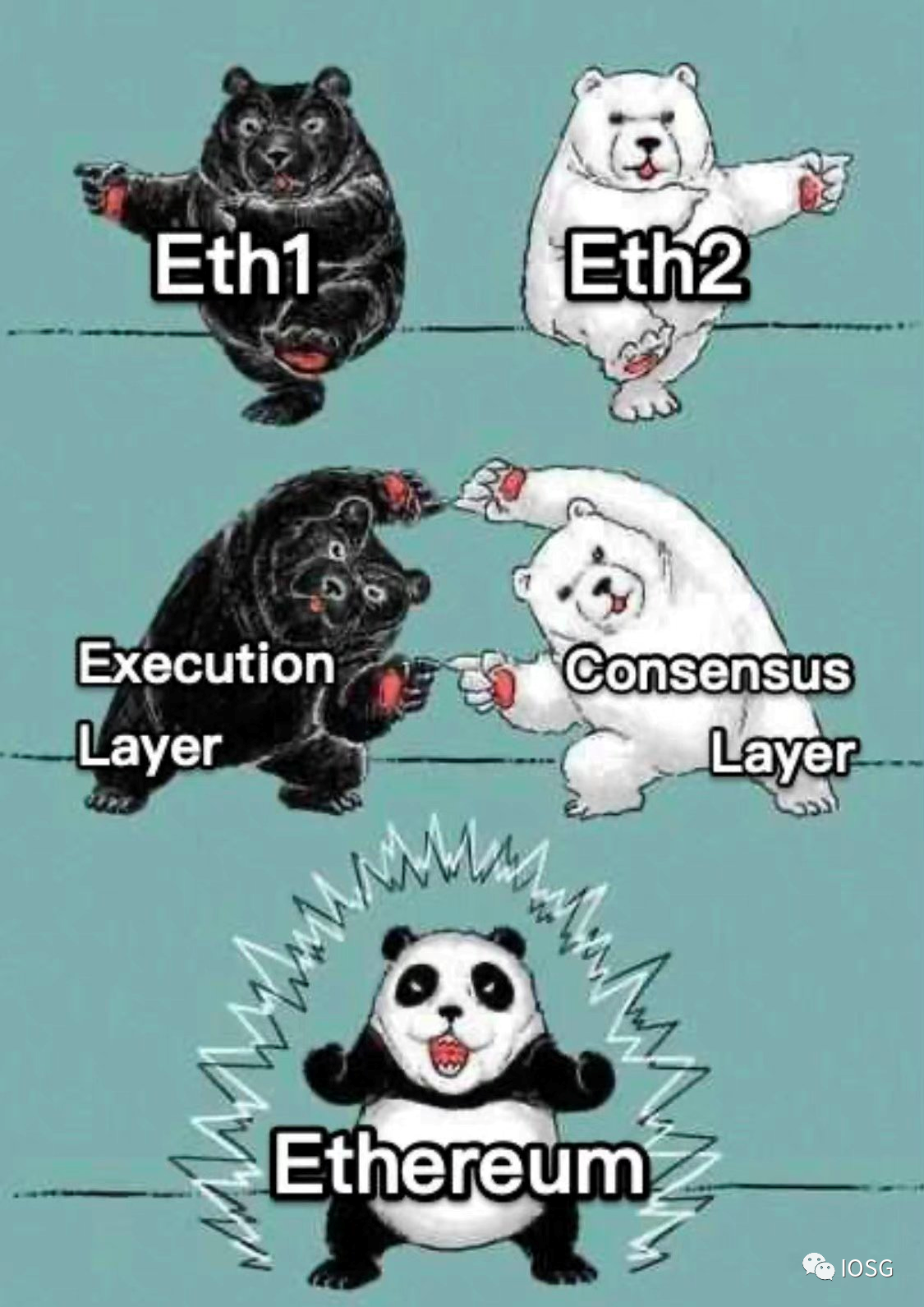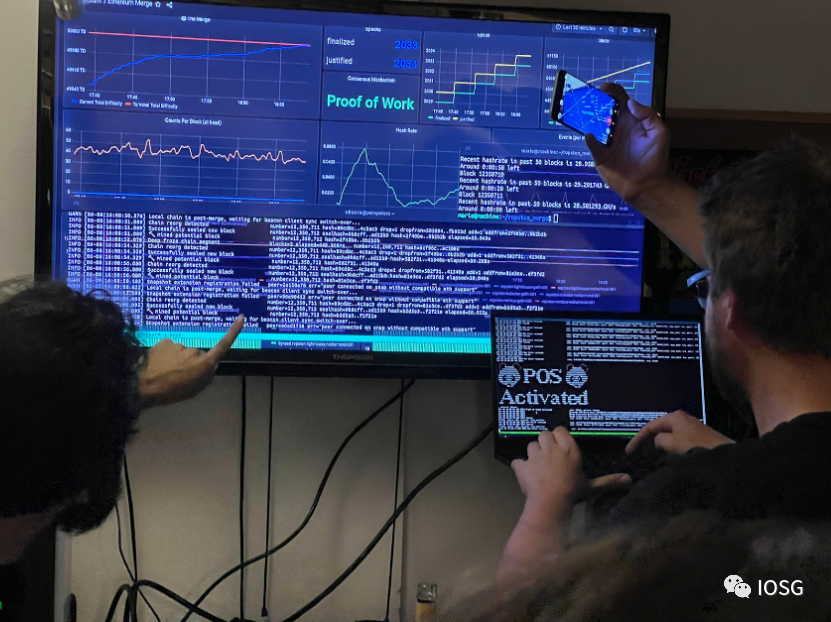first level title
Original source: IOSG Ventures

Key Takeaways
Last week, the merger was successfully implemented on Ropsten, the Ethereum test network, and PoS was officially enabled on Ropsten;
The merger on the Sepolia and Goerli testnets will take place in a few weeks;
If it goes well, the merger of the Ethereum mainnet is expected to be executed from late August to November;
In order to cooperate with the final mainnet The Merge, EIP-5133 proposes to restart the difficulty bomb of the mainnet in August;
Due to the gradual maturity of the second-layer expansion scheme, the current work focus of Ethereum has shifted from establishing shard chains to supporting the merger of the main network and the beacon chain. Shard chains are expected to be supported in 2023.
first level title
Ropsten & Merge
 In the early hours of June 9, 2022, Beijing time, the Ethereum test network Ropsten successfully completed the merger. Launched in 2016, Ropsten is the longest-running Ethereum testnet to date. According to the core developer of Ethereum, about 14% of validators experienced downtime during the merger process of Ropsten, but most of them were caused by wrong node configuration, and these problems were quickly resolved. Additionally, the merger on Ropsten is considered near-perfect and serves as an important milestone in Ethereum's migration to PoS.
In the early hours of June 9, 2022, Beijing time, the Ethereum test network Ropsten successfully completed the merger. Launched in 2016, Ropsten is the longest-running Ethereum testnet to date. According to the core developer of Ethereum, about 14% of validators experienced downtime during the merger process of Ropsten, but most of them were caused by wrong node configuration, and these problems were quickly resolved. Additionally, the merger on Ropsten is considered near-perfect and serves as an important milestone in Ethereum's migration to PoS.
In the future, the merger will be executed on the Sepolia (about 3 weeks later) and Goerli (about 6 weeks later) testnets. If all goes well, the ethereum mainnet is expected to be merged between late August and November.
Although it has been criticized in terms of environmental protection and energy consumption, PoW is the consensus algorithm with the longest running time after all. In comparison, PoS has not been tested for a long time. Especially for a huge ecology like Ethereum that affects the whole body, what potential impacts will there be after migrating to PoS is a question we have to consider.
secondary title
road to merger
The characteristics of an ideal blockchain include: sufficient transaction bandwidth, decentralization and security, and good energy efficiency. In order to achieve these goals, Ethereum plans to upgrade the PoS consensus mechanism and expand capacity based on Layer 2 and Sharding. The recent Merge in Ropsten is an important upgrade for Ethereum to address energy efficiency and improve decentralization and security.
beacon chain
beacon chain
The beacon chain supports nodes becoming validators of the network by staking Ethereum tokens. The beacon chain is the basic network of the consensus layer of Ethereum PoS, which was officially launched in December 2020.
Before The Merge happened, the beacon chain and the actual execution layer were separated from each other. The state of the PoS consensus layer is maintained independently by nodes in the beacon chain, but is not actually used by the blockchain. The state of the execution layer is maintained by the PoW mining nodes, and at the same time actually serves as the consensus layer.
The Merge:
The Merge will enable the beacon chain as the consensus layer network for Ethereum blocks, replacing the original consensus mechanism actually controlled by the PoW node network. The third block shown in the figure below is the key point of The Merge: the state of the execution layer in this block is inherited from the original PoW network, while the consensus layer is inherited from the PoS network. Since then, Ethereum has successfully switched to the PoS consensus mechanism.
Ethereum has designed a difficulty bomb mechanism to assist the switch from PoW to PoS. After the difficulty bomb is activated, the mining difficulty of the PoW network will increase exponentially and eventually freeze. As can be seen from the figure below, there have been three difficulty bombs in the history of Ethereum that raised the difficulty of block generation.
After completing the merger of Ropsten, Ethereum will follow the path to start the mainnet merger. According to EIP-5133, the difficulty bomb used to assist the Ethereum mainnet The Merge will be activated in August 2022.
epilogue
epilogue
From the narrative level, the most intuitive impact of Ethereum’s transition to PoS is better sustainability (more than 99% reduction in energy consumption compared to PoW), and the scalability brought about by the implementation of sharding in 2023 .
The transition to an environmentally friendly PoS will at least help ease the criticism of cryptocurrencies from the mainstream voice, and after sharding is adopted, supplemented by scaling infrastructure such as Rollup, we are expected to see a more scalable Ethereum. We are entering the phase of a new Ethereum narrative.
It has been a year and a half since the launch of the Ethereum Beacon Chain. There have been several development delays during this journey, but with the successful merger of the Ropsten testnet, we are getting closer to the merger of the Ethereum mainnet.
The merger is the most complex upgrade of ethereum to date. In the image above, we can see that the end point is very close. When reviewing the Ropsten Community Call live, we really felt the developers' heartfelt excitement.
Although the market may be in a continuous downward trend in the medium and long term, we are still excited about this milestone event and have full confidence in the future of Ethereum.
Original link